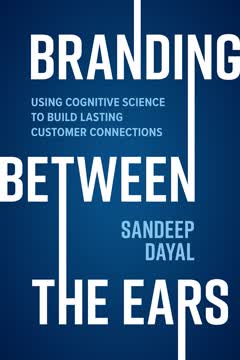Key Takeaways
1. Cognitive brands work the way the brain does, tapping into subconscious decision-making
Cognitive brands are the keys to unlocking the sensations of experiences and fantasies stored in our minds, to make us happier and lure us to the brand.
Brain-brand alignment. Cognitive branding leverages recent advances in neuroscience and psychology to design brand experiences that mirror how the human brain actually processes information and makes decisions. This approach recognizes that up to 95% of consumer choices occur subconsciously, driven by mental shortcuts and emotional associations rather than purely rational deliberation.
Key brain processes. The cognitive branding framework focuses on four main functional subunits of the brain:
- Associator: Draws on past experiences to make quick, intuitive judgments
- Deliberator: Engages in more effortful, analytical thinking when needed
- Learner: Continuously encodes and updates brand-related memories and associations
- Conator: Drives motivation and action based on anticipated happiness and personal goals
By aligning brand strategies with these natural cognitive processes, marketers can create more compelling and memorable brand experiences that resonate deeply with consumers on both conscious and subconscious levels.
2. Brand vibes create emotional connections and shared values with consumers
Brand vibes are compacts, not fantasies. Brands that betray the confidences they build with their customers can find themselves deep in a hole they cannot climb out of.
Emotional resonance. Brand vibes are the initial emotional connections that a brand forms with consumers, setting the stage for deeper engagement. These vibes can be created in two primary ways:
- Shared feelings: Demonstrating empathy and understanding of consumer experiences
- Shared values: Aligning the brand with causes or principles important to the target audience
Trust-building. Effective brand vibes build trust by:
- Acknowledging consumer pain points or aspirations
- Demonstrating authentic commitment to shared values
- Creating a sense of kinship or belonging
Examples of powerful brand vibes:
- Subaru's subtle messaging to the LGBTQ+ community
- Ben & Jerry's commitment to social justice causes
- Nike's partnership with Colin Kaepernick
By establishing these emotional connections, brands prime consumers to be more receptive to their core value propositions and messaging.
3. System 1 Easers make brand choices feel instinctive and effortless
System 1 Easers are all about leading consumers to make sense of the brand proposition instinctively, by going with the flow instead of fighting it.
Cognitive ease. System 1 Easers tap into the brain's preference for quick, low-effort decision-making. They make brand choices feel:
- Familiar
- True and authentic
- Good
- Easy
Key cognitive biases. Marketers can leverage several cognitive biases to create System 1 Easers:
- Anchoring bias: Providing a reference point for comparisons
- Loss aversion: Emphasizing potential losses over gains
- In-group bias: Creating a sense of belonging or identity
- Choice-supportive bias: Reinforcing the positives of past choices
Examples of effective System 1 Easers:
- DiGiorno's "It's not delivery, it's DiGiorno" campaign
- RxBar's transparent ingredient list on packaging
- Staples' "Easy Button" concept
By aligning with these natural mental shortcuts, brands can become the instinctive, low-effort choice for consumers.
4. System 2 Deliberators engage conscious reasoning for complex brand decisions
System 2 Deliberators have other peculiarities. Since they require mental effort, they do not kick in unless necessary.
Conscious evaluation. System 2 Deliberators are engaged when consumers need to make more complex or high-stakes brand decisions. They work by:
- Amplifying perceived value
- Lowering perceived risk
- Providing credible reasons to believe
- Reframing the context of the decision
Cognitive behavior therapy inspiration. The author draws parallels between System 2 Deliberators and techniques used in cognitive behavior therapy to change thought patterns:
- No-brainer method: Making the value proposition overwhelmingly appealing
- Pleasure prediction: Vividly illustrating potential positive outcomes
- Fight-or-flight: Addressing fears or concerns head-on
- Flirting training: Allowing low-commitment trial experiences
Examples of effective System 2 Deliberators:
- Uber's initial value proposition of convenience and cost savings
- Warby Parker's home try-on program
- Patek Philippe's reframing of watches as family heirlooms
By engaging System 2 processes, brands can overcome initial hesitations and build more enduring loyalty, especially for high-involvement purchases.
5. Brand resolve motivates consumers to act by aligning with their pursuit of happiness
Brands that find a way to be of help to the consumer in this quest are preferred and loved longer by consumers.
Happiness drivers. Brand resolve taps into the universal human pursuit of happiness by addressing three core intrinsic motivations:
- Need for autonomy: Feeling in control of one's choices and destiny
- Need for competence: Mastering skills and feeling capable
- Need for relatedness: Connecting with others and being part of something larger
Conative energy. Different consumers have varying tendencies to pursue these needs, which influences their brand preferences and behaviors. Marketers can use tendencies-based consumer segmentation to target the right audiences with the most compelling happiness propositions.
Examples of effective brand resolve strategies:
- National Car Rental's "Go Like a Pro" campaign (autonomy)
- Mastercard's "Priceless" campaign (relatedness)
- PediaSure's positioning as enabling children to "grow up to be all they can be" (competence)
By positioning brands as keys to unlocking specific forms of happiness, marketers can create stronger resolve among consumers to choose and stick with their products or services.
6. Effective brand execution considers how the brain processes and remembers experiences
Brand impressions are based on only a small part of the total brand experience, namely, the climax and the end.
Selective memory. The brain doesn't equally process or remember all aspects of a brand experience. Key principles for effective execution include:
- Peak-end rule: Focus on creating memorable high points and strong conclusions
- Novelty bias: Unexpected elements are more likely to be noticed and remembered
- Story-based recall: Narratives are more easily remembered than lists of facts or benefits
- Multisensory engagement: Involving multiple senses creates stronger, more holistic memories
Execution strategies:
- Create distinct "brand signatures" across sensory touchpoints (visual, auditory, olfactory, etc.)
- Use storytelling to make brand benefits more memorable and relatable
- Surprise and delight customers with unexpected positive experiences
- Ensure the climax and conclusion of brand interactions are especially positive
Examples of effective sensory branding:
- Singapore Airlines' custom fragrance used throughout the flight experience
- Burberry's distinctive visual patterns and in-store scents
- John West's unexpected and humorous "bear fight" commercial
By aligning brand execution with how the brain naturally processes and remembers information, marketers can create more impactful and lasting brand impressions.
7. Ethical cognitive branding respects consumer autonomy and societal well-being
Just because you can, should you?
Ethical considerations. With great power comes great responsibility. As cognitive branding techniques become more sophisticated, marketers must consider the ethical implications of their strategies. Key ethical tests include:
- Canonical Imperative: Would you want this done to you?
- Categorical Imperative: Would it be good if everyone did this?
- Sunshine Imperative: Would you be comfortable if this strategy was made public?
Potential pitfalls:
- Manipulative dark patterns in user interfaces
- Exploiting cognitive biases to drive excessive consumption
- Misrepresenting product benefits through subliminal cues
Responsible practices:
- Transparency in marketing claims and pricing
- Aligning brand purpose with genuine societal benefits
- Respecting consumer privacy and data autonomy
- Empowering informed decision-making
By adhering to ethical principles, cognitive branding can create win-win outcomes that benefit both brands and consumers while contributing positively to society.
Last updated:
FAQ
What's Branding Between the Ears about?
- Cognitive Science Application: The book delves into how cognitive science principles can be applied to branding, focusing on psychological triggers that make brands resonate with consumers.
- Cognitive Branding Model: It introduces "cognitive brands," which are designed to align with the brain's natural processes, emphasizing elements like good vibes, sense, and resolve.
- Practical Insights: The author provides actionable frameworks and real-world examples for marketers to create brands that connect deeply with consumers.
Why should I read Branding Between the Ears?
- Transformative Perspective: The book offers a fresh take on branding by integrating neuroscience and psychology, moving beyond traditional methods.
- Actionable Strategies: Readers gain practical tools and frameworks that can be immediately applied to enhance branding efforts.
- Credible Resource: Endorsed by industry leaders, it serves as a reliable guide for marketers aiming to innovate and connect with consumers.
What are the key takeaways of Branding Between the Ears?
- Cognitive Brands: Successful brands align with how the brain processes information, focusing on emotional and psychological connections.
- Three Elements: The book highlights brand vibes (empathy), brand sense (making sense of choices), and brand resolve (motivating purchases) as key components.
- Behavioral Insights: Understanding consumer behavior through cognitive biases is crucial for effective branding strategies.
What is the concept of "cognitive branding" in Branding Between the Ears?
- Definition: Cognitive branding involves designing brands that resonate with the brain's natural processes, making them more appealing and memorable.
- Three Components: It includes brand vibes (emotional connection), brand sense (intuitive understanding), and brand resolve (motivation to purchase).
- Practical Framework: The book provides a framework for marketers to create cognitive brands by leveraging consumer psychology.
How does Branding Between the Ears define "brand vibes"?
- Emotional Connection: Brand vibes are the emotional bonds that brands create with consumers, making them feel understood and valued.
- Empathy and Trust: Establishing good vibes involves showing empathy towards consumer experiences and aligning with their values, fostering trust.
- Foundation for Value Proposition: Good brand vibes set the stage for consumers to accept and embrace the main brand message more readily.
What are "System 1 Easers" and how do they work in branding according to Branding Between the Ears?
- Definition: System 1 Easers are elements that help consumers make intuitive and instinctive choices about brands without deep deliberation.
- Cognitive Ease: They create a sense of familiarity, truth, goodness, or ease, making the brand choice feel effortless and natural.
- Examples: Techniques like anchoring bias and loss aversion bias are used to align brand messages with consumers' existing beliefs and preferences.
How does Branding Between the Ears suggest using "System 2 Deliberators" in branding?
- Analytical Thinking: System 2 Deliberators engage consumers in logical reasoning, helping them evaluate the brand's value proposition critically.
- Four Strategies: The book outlines strategies like amplifying value, lowering risk, providing reasons to believe, and framing the brand choice favorably.
- Consumer Empowerment: These strategies help consumers feel more confident in their decisions, leading to stronger brand loyalty.
What role does emotional branding play in Branding Between the Ears?
- Emotional Resonance: Emotional branding is crucial for creating connections that resonate with consumers on a deeper level, influencing their perceptions and choices.
- Risk of Overemphasis: The book warns that overly emotional branding can overshadow the brand itself, leading to poor recall of the brand name.
- Balanced Approach: Successful branding should balance emotional appeal with clear brand messaging to ensure consumers remember both the feelings and the brand.
How can brands create a sense of "resolve" according to Branding Between the Ears?
- Motivation to Act: Brand resolve is about encouraging consumers to take action and make a purchase by linking the brand to their happiness and goals.
- Personal Connection: Brands should resonate with consumers' aspirations and values, making them feel that purchasing the brand will enhance their lives.
- Overcoming Indecision: By addressing consumer hesitations and providing compelling reasons to buy, brands can effectively motivate consumers to choose their products.
How does Branding Between the Ears define happiness in the context of branding?
- Happiness as a Goal: The author states that "all consumers pursue happiness as a conscious or subconscious goal," central to their decision-making.
- Neurochemical Basis: Happiness is linked to the release of specific brain chemicals (dopamine, oxytocin, serotonin, and endorphins) that brands can trigger through positive experiences.
- Anticipatory vs. Consummatory Pleasures: The book differentiates between anticipatory pleasures (imagining future happiness) and consummatory pleasures (experiencing happiness), both of which brands can leverage.
What are some examples of successful brands mentioned in Branding Between the Ears?
- PediaSure: Successfully repositioned from a hospital product to a household brand by addressing parents' concerns about children's nutrition.
- Mastercard: The "Priceless" campaign effectively connected emotional experiences with its brand, enhancing consumer loyalty.
- National Car Rental: The "Go Like a Pro" campaign targeted frequent business travelers by appealing to their need for autonomy and control.
What ethical considerations does Branding Between the Ears address?
- Manipulation vs. Influence: The author warns against using cognitive branding techniques to manipulate consumers in ways that could harm their well-being or financial stability.
- Three Ethical Tests: Introduces the Canonical Imperative, Categorical Imperative, and Sunshine Imperative to help marketers evaluate their strategies.
- Responsibility in Marketing: Marketers are encouraged to use their knowledge of cognitive science responsibly, ensuring that their branding efforts benefit consumers rather than exploit them.
Review Summary
Branding Between the Ears receives mostly positive reviews, with readers praising its insights into cognitive science and marketing strategies. Many find it valuable for understanding how brands can leverage brain science to create lasting customer connections. The book is commended for its clear structure, recent examples, and practical takeaways. Some readers appreciate the author's humor and accessible explanations of complex concepts. However, a few reviewers note that the book may require focused attention and contains numerous pharmaceutical industry examples.
Similar Books









Download PDF
Download EPUB
.epub digital book format is ideal for reading ebooks on phones, tablets, and e-readers.




